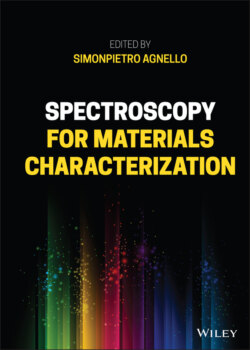Читать книгу Spectroscopy for Materials Characterization - Группа авторов - Страница 69
3.5.3 Data Analysis and Interpretation
ОглавлениеData analysis of TRR data involves a series of additional steps which do not have a counterpart in TA, and the details of which depend on the specific pulse sequence used in the acquisition. A typical analysis workflow is illustrated in [65]. If chopping the actinic pump only, one can directly acquire the difference Raman spectrum induced by photoexcitation. The latter will always “sit” over a broad background due to transient absorption changes of the Raman probe beam. Therefore, one always needs to separately measure the TA and subtract it from the recorded signal. The signal after TA subtraction contains the excited state Raman spectrum, ground state Raman bleach contributions, but also some residual contributions of the solvent, due to attenuation of the Raman pump by photoexcited molecules. Therefore, one needs to separately measure and subtract the pure solvent Raman signal, which is rescaled and subtracted in order to get the final difference spectrum. Some specific additional problems which are not encountered in TA may arise both at the time of setup alignment or data processing. For example, the data may contain spurious contributions due to the cross‐phase modulation between Raman pump and probe beams. Several strategies have been proposed to minimize these effects, such as vibrating the Raman pump retroreflector to average out CPM effect [61].
TRR experiments exploiting stimulated Raman scattering are now very well‐established in the toolbox of ultrafast spectroscopies. They are powerful tools capable of following the ultrafast dynamics of photoexcited systems by revealing structurally precise details of the undergoing events through the changes of their vibrational mode pattern. The interpretation of time‐resolved vibrational data follows basically the same principles as ordinary steady state vibrational spectroscopy, where characteristic fingerprint vibrations are highly structure‐specific and, in some frequency regions, can be traced back to specific chemical moieties. The main difference with a steady state Raman experiment is that the vibrational properties change as a result of the electronic redistribution induced by photoexcitation, and of subsequent system dynamics. For example, molecular internal conversion can be pinpointed unambiguously through the appearance and disappearance of the unique fingerprint vibration patterns associated to each of the involved states [66]. On these grounds, TRR methods have been extensively used to interrogate ultrafast photochemical processes such as charge transfer, proton transfer, isomerization, or internal conversion, as demonstrated by many examples in the literature of the last two decades [50, 53, 66, 67].
